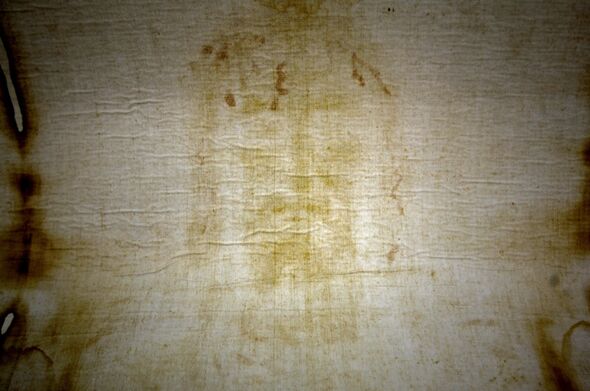
The exact origins of the relic are shrouded in mystery (Image: AFP via Getty Images)
The mysterious Shroud of Turin was first put on public display 91 years ago this week. For all of those decades, experts have debated how the unique image on the Shroud was formed.
Many Christians believe it was the burial cloth used to cover Jesus Christ after his crucifixion – with an imprint of his face visible. Sceptics suggest it was simply the work of an artist, although no particles of any paint have been found.
And recent carbon-dating tests claimed to have put the Shroud’s origin somewhere in the early 14th Century – putting further into doubt the links to Jesus.
But Russ Breault, who has studied the Shroud for years and has even written a book about it, says questions still remain about how the relic was created.
He told Express.co.uk: “The image is so superficial as to penetrate only the top one to two microfibres of the cloth—or about 1% of a single thread.
“It does not penetrate the cloth as does the blood. As for why the image appears, something has caused the rapid dehydration and oxidation of the flax fibres bringing about a discolouration of the cloth but only in those areas immediately surrounding a body.”

Russ Breault has studied the Shroud’s history for many years (Image: Russ Breault)
Don’t miss… ‘Face of Jesus’ unveiled by AI using Shroud of Turin after astonishing discovery [LATEST]
Simply burning the cloth wouldn’t produce such an even scorch mark. However, Russ says, the Bible hints at a supernatural burst of energy that has now been reproduced in a lab. “While there were multiple post-resurrection appearances of Jesus, there were no eyewitnesses to the resurrection event itself,” he continued.
“Yet there are biblical references to Jesus appearing as a being of light to Peter, James and John on the Mount of Transfiguration, and his appearance to Saul (who becomes Paul) as brilliant flash of light blinding him for three days. Both would seem to indicate an intense burst of light at the point of resurrection.”

Bloodstain analysis shows that whoever was wrapped in the shroud died in extreme pain (Image: Russ Breault)

Physicist Paolo Di Lazzaro managed to recreate the enigmatic image using a high-powered laser (Image: ResearchGate)
Russ pointed out research conducted by Italian Physicist, Paolo Di Lazzaro, who used high power lasers to recreate the extreme superficial nature of the image along with the same coloration using a 40 nano-second burst from an ultraviolet laser against a control sample of linen.
“This was the first time any aspect of the Shroud image has been duplicated using light,” Russ added.
He believes that, at the moment of Christ’s resurrection, a massive energy surge – similar in effect to a modern high-powered laser – rushed through his body.
Supporting his theory is the fact that the bloodstains on the Shroud appear to have been formed before the image of the body. That may suggest that the cloth was placed around a mortally wounded body before the image was formed.

The Vatican has placed a limit on DNA testing of the relic (Image: Russ Breault)
He continued: “There is no image under the blood, which means the blood must have been on the cloth first, followed by the image. This makes sense if the Shroud is authentic…Good Friday followed by Easter Sunday. But it makes no sense as the work of an artist, in fact, it would be impossible.”
Analysis of the bloodstains themselves only casts further doubt on the theory that the relic was somehow faked, according to Russ.
He explained: “To complicate matters for our elusive medieval artist is that the blood has been determined to be type AB human blood, but not whole blood as if painted onto the cloth with a brush, but rather the exudate from actual wounds showing a high content of bilirubin, a breakdown byproduct of red blood cells that occurs during conditions of extreme physical stress…crucifixion perhaps?”

The bloodstains (shown here in white) apparently formed before the image (Image: Russ Breault)
Chemical analysis of the blood revealed little more about the person whose body formed the one-of-a-kind image. DNA analysis carried out in 1995 by microbiologist Leoncio Garza-Valdez determined it to be that of a human male.
The sample was taken from a blood particle removed from the back of the head in 1988. But, Russ notes: “The test is not considered to be definitive as the problem with DNA is that anyone who ever touched the cloth left their DNA on it as well.”
It’s unlikely, however that any further testing will be done for a very particular reason. He continued: “The sample examined in 1995 was very degraded and beyond finding X and Y chromosomes, not much else could be determined such as ethnicity. The Catholic Church did not authorise the DNA test and reacted by forbidding anyone from conducting any more such testing for fear of some nefarious attempt to clone Jesus.”
Russ Breault’s book SHROUD ENCOUNTER: Explore the World’s Greatest Unsolved Mystery, in on sale now, published by Covenant Books.
